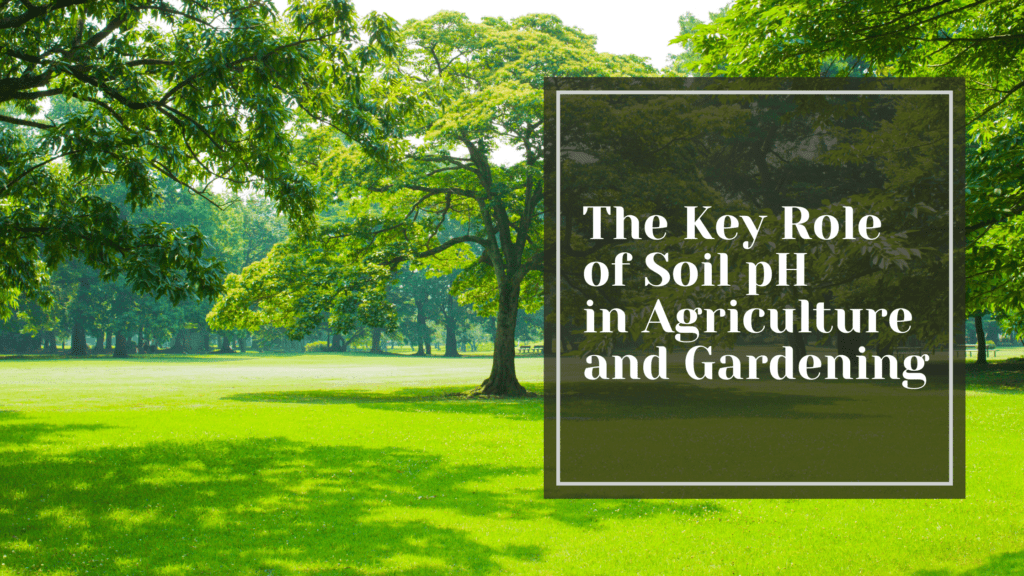Landscaping is an art. It involves designing and maintaining lawns, gardens, and outdoor spaces to create visually appealing and functional environments. Plant health is a key element that determines the success of a landscape. Plants require specific environmental conditions to thrive, and one of the most important factors to that growth is perfect soil pH. In this blog, we will discuss the impact of soil pH on plants and how to maintain ideal pH levels for healthy plants.
Table of Contents
ToggleWhat is pH?
Essentially, anything with water in it will have a pH – including the soil in your yard! pH is a chemical measure of acidity or alkalinity. It stands for “potential hydrogen”, but you don’t need to know the exact science to understand how it works.
The pH scale ranges from 0 to 14.
pH levels from 0 to 7 are considered acidic, while 7 to 14 are alkaline.
A pH of 7 is neutral, meaning neither acidic nor basic – essentially the baseline. Most plants prefer a slightly acidic soil pH between 6.0 and 7.0. When the soil pH is outside this range, it can affect the availability of nutrients, soil structure, and the overall health of the plants.
The Impact of Perfect Soil pH on Plant Health
Perfect soil pH affects plant growth by influencing the availability of essential nutrients. Plants require various nutrients to grow, including nitrogen, phosphorus, potassium, and calcium. These nutrients are most available to plants when the soil pH is in the optimal range of 6.0 to 7.0. When the soil pH is too low or too high, some nutrients become less available to plants. For example, in acidic soils, aluminum and manganese can become toxic to plants. In alkaline soils, iron and phosphorus become less available to plants.
Importance of Soil pH for Soil Structure and Plant Growth
In addition to nutrient availability, soil pH also affects the structure and texture of the soil. Acidic soils tend to be sandy and loose, while alkaline soils tend to be heavy and clay-like. This can affect the ability of plants to absorb water and nutrients from the soil, leading to stunted growth or even death.
Finding Properties with Healthy Soil
If healthy soil is vital to you, psychically visiting properties you’re considering purchasing is essential. You should always visit the land you’re considering acquiring to check the soil. Be sure to use information from this article and check out resources like Curtis Stone’s guide on finding perfect homestead properties to ensure you purchase quality land.
Maintaining Optimal Soil pH
To maintain the ideal soil pH for plant health, it’s essential to test your soil somewhat regularly – about every year or two. Soil testing kits are readily available and can be purchased at most garden centers or online. The kit should give you an accurate reading of the pH to help you determine the appropriate course of action.
Lime is a common soil amendment that’s readily available and can be added to the soil at any time of year. The amount of lime needed will depend on the current pH level and the type of soil. If the soil pH is too low (acidic), adding lime to the soil can help to raise the pH.
Adjusting Soil pH with Sulfur
If the soil pH is too high (alkaline), adding sulfur to the soil can help to lower the pH. Sulfur is also readily available and can be added to the soil at any time of year. The amount of sulfur needed will depend on the current pH level and the type of soil.
Choosing Plants Based on pH Level
In some cases, it may be more practical to choose plants that are well-suited to the soil pH in your area. Native plants are often an excellent choice as they are adapted to the local soil conditions and climate. In addition, choosing plants that are tolerant of a range of soil pH levels can help to ensure success in your landscaping efforts.
Maintaining the Ideal Soil pH for Healthy Plants and Landscaping Success
Soil pH is an important consideration in landscaping and critical for plant health overall. The ideal soil pH for most plants is slightly acidic, between 6.0 and 7.0. When the soil pH is too low or too high, it can impact the availability of nutrients, soil structure, and the overall health of the plants. To maintain the ideal soil pH, it is essential to test the soil regularly and adjust the pH as needed. By following these steps, you can ensure healthy plants and a successful landscape.







